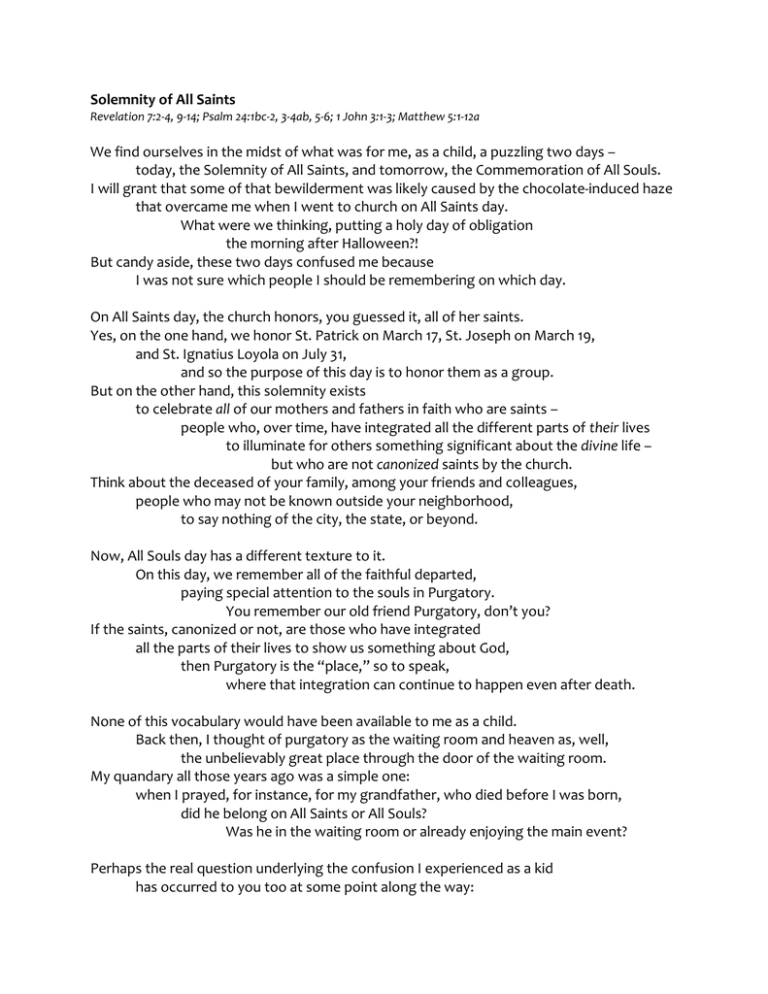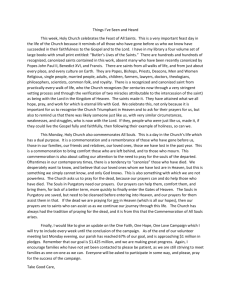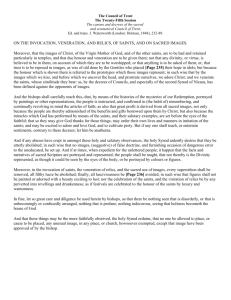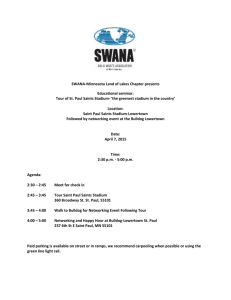Solemnity of All Saints
advertisement

Solemnity of All Saints Revelation 7:2-4, 9-14; Psalm 24:1bc-2, 3-4ab, 5-6; 1 John 3:1-3; Matthew 5:1-12a We find ourselves in the midst of what was for me, as a child, a puzzling two days – today, the Solemnity of All Saints, and tomorrow, the Commemoration of All Souls. I will grant that some of that bewilderment was likely caused by the chocolate-induced haze that overcame me when I went to church on All Saints day. What were we thinking, putting a holy day of obligation the morning after Halloween?! But candy aside, these two days confused me because I was not sure which people I should be remembering on which day. On All Saints day, the church honors, you guessed it, all of her saints. Yes, on the one hand, we honor St. Patrick on March 17, St. Joseph on March 19, and St. Ignatius Loyola on July 31, and so the purpose of this day is to honor them as a group. But on the other hand, this solemnity exists to celebrate all of our mothers and fathers in faith who are saints – people who, over time, have integrated all the different parts of their lives to illuminate for others something significant about the divine life – but who are not canonized saints by the church. Think about the deceased of your family, among your friends and colleagues, people who may not be known outside your neighborhood, to say nothing of the city, the state, or beyond. Now, All Souls day has a different texture to it. On this day, we remember all of the faithful departed, paying special attention to the souls in Purgatory. You remember our old friend Purgatory, don’t you? If the saints, canonized or not, are those who have integrated all the parts of their lives to show us something about God, then Purgatory is the “place,” so to speak, where that integration can continue to happen even after death. None of this vocabulary would have been available to me as a child. Back then, I thought of purgatory as the waiting room and heaven as, well, the unbelievably great place through the door of the waiting room. My quandary all those years ago was a simple one: when I prayed, for instance, for my grandfather, who died before I was born, did he belong on All Saints or All Souls? Was he in the waiting room or already enjoying the main event? Perhaps the real question underlying the confusion I experienced as a kid has occurred to you too at some point along the way: what are we supposed to do with these two days, or for that matter, the month of November, a month dedicated to the saints, but also to the faithful departed? I would like to suggest that these days that ask us to focus on others, on the saints and on the deceased who are even now becoming saints, are actually meant to teach us something about ourselves – about how we ought to live, about how we can become saints. To my mind, it all hinges on this idea of integration. I mentioned integration earlier when I spoke of the saints, calling them people who, over time, have integrated all the different parts of their lives to illuminate for others something significant about the divine life. This is not to say that the saints are perfect. History assures us that, in fact, none of them is. But each of them has achieved some high level of integration, of authenticity, whereby all the different parts of their lives – their actions, their words, their thoughts, their hopes, their intentions – all these parts of their lives are working in harmony with one another, with Christ at their very foundation. The saints even manage to make peace with their history of sin, showing contrition, becoming free from guilt, and truly amending their lives. If you would like a different way of thinking about it, recall the gospel reading we just heard. If somehow we lost the list of the beatitudes in a fire that magically burned the fifth chapter of Matthew’s Gospel in every single bible, we could look at the lives of the saints and have some hope of reconstructing them. All Saints day, then, sets the goal for us, the goal of integration, and shows that the goal is, with God’s grace, achievable. And it is achievable not just for the sorts of people who wind up on stained-glass windows. It is possible for people we know, people like my grandfather, people like the ones you are thinking of right now. And if it is possible for them, then it is possible for us. But integration is a process. Sometimes, a very slow process. If we had to depend on my life, for instance, to reconstruct the list of the beatitudes, I would suggest that all of us go home and fire-proof our bibles. This is no throw-away line! 2 My life, and I would guess the same is true for most of you, is not integrated as fully as it could be. Thanks be to God, it is not, I hope, completely dis-integrated, that is, it could not be used to construct a list of anti-beatitudes, but it still has a long way to go. All Souls day, then, gives us hope that it is okay to be where we are. Indeed, it gives us the tremendous comfort to know that even death itself is not some hard and fast cutoff, whereby we either have it completely together, or we do not even make it into the waiting room. This, of course, is not an invitation to kick back, live a life of mediocrity, and worry about integration only when we die. Rather, it is an indication of just how badly God wants to see us remembered by our descendants, not just on All Souls day, but on All Saints day as well. In spending this month of November remembering people who are not here – the faithful departed, and the communion of saints, be they canonized by the church or canonized by our hearts – we have the great opportunity to learn something about ourselves. The saints show us what it is to be integrated, and so many different ways of getting there; and the faithful departed remind us that getting there, becoming integrated, is a process. May the Eucharist we celebrate today, in honor of All the Saints, be for us real food, a foreshadowing of the heavenly banquet at which the saints have already taken their seats. 3






